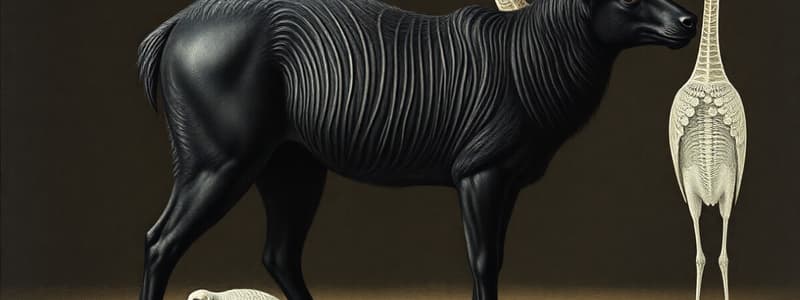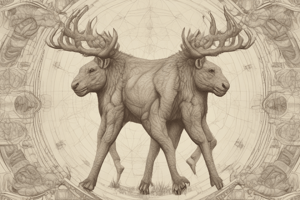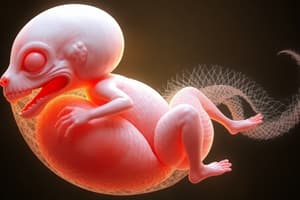Podcast
Questions and Answers
An animal that maintains a constant internal body temperature independent of the external environment would be considered a:
An animal that maintains a constant internal body temperature independent of the external environment would be considered a:
- Homeotherm (correct)
- Ectotherm
- Poikilotherm
- Conformer
Which of the following is an example of negative feedback in maintaining homeostasis?
Which of the following is an example of negative feedback in maintaining homeostasis?
- Regulation of blood glucose levels by insulin (correct)
- Blood clotting
- Release of oxytocin during childbirth
- Fever increasing body temperature
Which of the following best explains why simple animals can rely on diffusion for gas exchange, while larger more complex ones need specialized respiratory systems?
Which of the following best explains why simple animals can rely on diffusion for gas exchange, while larger more complex ones need specialized respiratory systems?
- Simple animals live mostly in water, allowing for more efficient diffusion.
- Larger animals need more oxygen to support their higher metabolic rates.
- The surface area to volume ratio decreases as an animal grows larger, limiting the area available for diffusion. (correct)
- Larger animals are exposed to more dangerous environments needing more complex respiratory strategies.
Why is the removal of nitrogenous wastes important for animals?
Why is the removal of nitrogenous wastes important for animals?
What is the primary advantage of a complete digestive system compared to a simple digestive system?
What is the primary advantage of a complete digestive system compared to a simple digestive system?
Which of the following accurately describes the path of blood flow through a four-chambered heart?
Which of the following accurately describes the path of blood flow through a four-chambered heart?
What is the primary function of valves in veins?
What is the primary function of valves in veins?
How does the surface area to volume ratio affect an animal's ability to exchange materials with its environment?
How does the surface area to volume ratio affect an animal's ability to exchange materials with its environment?
How does the countercurrent exchange mechanism in fish gills facilitate efficient oxygen uptake?
How does the countercurrent exchange mechanism in fish gills facilitate efficient oxygen uptake?
What is the functional unit of the vertebrate kidney?
What is the functional unit of the vertebrate kidney?
Flashcards
Radial Symmetry
Radial Symmetry
Arrangement around a central axis
Triploblastic
Triploblastic
Having three germ layers: ectoderm, mesoderm, and endoderm.
Acoelomate
Acoelomate
No body cavity
Eucoelomate
Eucoelomate
Signup and view all the flashcards
Pseudocoelomate
Pseudocoelomate
Signup and view all the flashcards
Homeostasis
Homeostasis
Signup and view all the flashcards
Ectotherm
Ectotherm
Signup and view all the flashcards
Endotherm
Endotherm
Signup and view all the flashcards
Osmosis
Osmosis
Signup and view all the flashcards
Excretory Systems
Excretory Systems
Signup and view all the flashcards
Study Notes
- The following are key topics for study, broken down by chapter:
Ch. 30: Animals - Body Plans/Trends
- Study animal symmetry types like radial and bilateral
- Understand benefits to each type
- Study the diversification of tissues, including diploblastic and triploblastic organisms
- Understand body cavity types (acoelomate, eucoelomate, pseudocoelomate) and their relation to animal relatedness
- Study animal segmentation, its benefits, and animals that exhibit it
- Study the origins of animals by understanding the syncytial ciliate hypothesis and the colonial flagellate hypothesis
- Review feeding categories/lifestyles of animals
- Know the basal groups of animals
Ch. 31-32: Groups of Animals
- Study major branches and groups of animals
- Review the taxonomy sheet for all groups with general knowledge about each
Ch. 39: How Animals Work - Levels of Organization
- Know how surface area to volume ratio influences scalability in animals
- Study basic tissue types:
- Epithelial tissues, including simple and stratified types, shapes (cuboidal, squamous, columnar), and locations
- Connective tissues, know characteristics and examples like adipose, blood, cartilage, bone and loose connective tissue
- Nervous tissue
- Muscle tissue, including types like cardiac, striated, and smooth
- Review homeostasis by knowing the terms:
- Ectothermy
- Endothermy
- Poikilothermy
- Homeothermy
- Study regulators/conformers, know examples
- Understand homeostatic control via negative and positive feedback mechanisms
- Study heat exchange types and directions
- Know the Q10 effect
- Study metabolic heat production mechanisms
- Review hibernation/torpor
Ch. 40: Osmoregulation/Excretion - Water Balance Issues
- Study freshwater vs. marine concerns regarding water balance
- Define anadromy and catadromy
- Study the basics of osmosis in animals
- Review how animals prevent desiccation/water loss.
Excretory Systems
- Nitrogenous waste removal is important
- Study methods for disposal in different groups of animals
- Study aspects of excretory systems
- Know the different types of excretory wastes removed by different animals and why
- Study the different types of excretory organs discussed and their parts:
- Protonephridia
- Metanephridia
- Malphigian tubules
- Know the parts of the nephron and the vertebrate kidney
Ch. 41: Digestion
- Study various types of dentition and feeding adaptations
- Review basic setups for simple digestive systems
- Review the basic setup for mammalian digestive tract
- Know the digestive organs, including accessory organs, and their functions
- Study the chart for chemical digestion, noting enzymes produced, where, and their actions
Ch. 42: Circulation/Gas Exchange - Gas Exchange
- Study gas exchange systems using diffusion, gills, lungs, skin, and tracheal systems
- Review common characteristics for respiratory surfaces and why
- Review the basic design of respiratory systems in mammals (lungs, capillaries, blood cells) and in birds (continuous breathing)
- Effects related to physics include osmosis, diffusion, partial pressures of gases, laws of continuity
Circulation
- Study circulatory system types and organisms containing them
- Review the differences between open and closed circulatory systems
- Study circulatory system differences in tetrapods
- Review double circulation and know what problem this solves, and how this relates to the number of heart chambers
- Review mixing of deoxy and oxy blood
- Know the basic path of blood through a 4-chambered heart and major associated vessels
- Review arteries, veins, and lymph vessels--definitions/differences
- Understand why veins have valves
- Know the parts of the human heart
- Know how blood pressure is measured and affected
- Review the different elements of blood and their roles
- Review how erythrocyte levels are maintained
- Define ischemic and hemorrhagic strokes
- Know what causes a heart attack
Studying That Suits You
Use AI to generate personalized quizzes and flashcards to suit your learning preferences.




